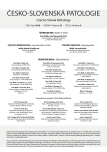Case report: Diagnosis under the microscope - disseminated echninococcosis, the multilocular form with protoscoleces
Authors:
Tomáš Jůza 1; Alena Jůzová 2; Tatiana Gajdošová 3
Authors place of work:
student, Masarykova univerzita – lékařská fakulta
1; Patologicko-anatomické oddělení Svitavské nemocnice a. s., nyní důchodce
2; Ústav patologie FN Brno
3
Published in the journal:
Čes.-slov. Patol., 52, 2016, No. 3, p. 168-172
Category:
Původní práce
Summary
Echinococcosis (hydatidosis) is a rare severe tissue parasitosis. In the Czech Republic it is caused by two species of tapeworm: Echinococcus granulosus or Echinococcus multilocularis. The species differ in both their usual hosts during their life cycle as well as in the typical form of lesions in infested tissues. In both cases the liver is the most common primary infested organ.
We describe an autopsy case of a massive hepatic parasitic lesion in an 81 year-old man. There were metastatic parasitic cysts in both lungs and the hepatic mass spread per continuitatem in the right adrenal gland. The lesion was microscopically represented by small cystic forms with PAS positive laminar membranes and frequent occurrence of protoscoleces in the peripheral parts of the liver and the adrenal gland.
The diagnosis of echinococcosis was settled after microscopic exploration of necroptic material. The overall appearance and pattern of spreading corresponded to alveolar echinococcosis, however the massive presence of protoscoleces in the liver is very rare for E. multilocularis. Protoscoleces are usually found in infections caused by E. granulosus. Cystic echinococcosis typically presents with one larger cyst or a small number of bigger cysts with prominent fibrous rim. Because of the unavailability of molecular diagnostic methods (PCR, immunohistochemistry), that are able to distinguish individual species of parasite, the case was closed according to the typical histological findings as disseminated alveolar echinococcosis with the rare appearance of protoscoleces with possible association with immunosuppressive therapy.
We have found about ten other cases of alveolar echinococcosis published in last ten years in the Czech Republic. All these cases were diagnosed in living patients. It is assumed that most of these patients were infected in the vicinity of their homes.
Keywords:
echinococcosis – hydatidosis – Echinococcus multilocularis – Echinococcus granulosus – protoscoleces
Zdroje
1. Votava M. Lékařská mikrobiologie speciální. (1. vyd). Brno: NEPTUN; 2003: 418-420.
2. Jírovec O. a spol. Parazitologie pro lékaře (3. vyd). Praha: Avicenum; 1977: 528-535.
3. Jíra J. Lékařská helmintologie Helmintoparazitární nemoci. Praha: Galén; 1998: 187-208.
4. Burt AD, Portmann BC, Ferrell LD. MacSween ́s Pathology of the Liver, (6th edn). Edinburgh: Elsevier; 2013: 437-438.
5. Eckert J. WHO/OIE manual on Echinococcosis in humans and animals: a zoonosis of global concern. Paris: World Organisation for Animal Health; 2001.
6. Kern P, Wen H, Sato N, et al. WHO classification of alveolar echinococcosis: Principles and application. Parasitol Int 2006; 55: Supplement: S283–S287.
7. Kinčeková J, Hrčková G, Szabadošová V, et al. Využitie PCR analýzy pre diagnostiku pacientov s alveolárnou echinokokózou pečene. Čes a Slov Gastroent a Hepatol 2007; 61(6): 304-308.
8. Jura H, Bader A, Hartmann M, Maschek H, Frosch M. Hepatic tissue culture model for study of host-parasite interactions in alveolar echinococcosis. Infect Immun 1996; 64(9): 3484-3490.
9. Tappe D, Frosch M. Rudolf Virchow and the recognition of alveolar echinococcosis, 1850s. Emerg Infect Dis 2007; 13(5): 732-735.
10. Hozáková-Lukáčová L, Kolářová L, Rožnovský L et al. Alveolární echinokokóza - nově se objevující onemocnění? Čas Lék čes 2009; 148(3) : 132-136.
11. Hozáková L, Capulič I. Zkušenosti s alveolární a cystickou echinokokózou. Seminář Společnost pro epidemiologii a mikrobiologii ČLS JEP, Společnost infekčního lékařství ČLS JEP, Česká parazitologická společnost echinokokové infekce 2014, http://www.parazitologie.cz/akce/doc/sbornik/2014%20seminar%20v%20LD_Hydatidoza.pdf
12. Šlais J, Mádle A, Vaňka K, et al. Alveolární hydatidóza diagnostikovaná punkční jaterní biopsií. Čas Lék čes 1979, 118(15): 472-475.
13. Pavlásek I, Horyna B, Chalupský J, Kolářová L, Ritter J. Výskyt Echinococcus multilocularis u lišek v České republice. Epidemiol Mikrobiol Imunol 1997; 46(4): 158–162.
14. Huang M, Zheng H. Primary alveolar echinococcosis (Echinococcus multilocularis) of the adrenal gland: report of two cases. Int J Infect Dis 2013; 17(8): e653–655.
15. Skiepko R, Zietkowski Z, Skiepko U, Tomasiak-Lozowska MM, Bodzenta-Lukaszyk A. Echinococcus multilocularis Infection in a Patient Treated With Omalizumab. Investig Allergol Clin Immunol 2013; 23(3): 197-211.
16. Geyer M, Wilpert J, Wiech T, et al. Rapidly progressive hepatic alveolar echinococcosis in an ABO-incompatible renal transplant recipient. Transpl Infect Dis 2011; 13(3): 278–284.
17. Dražilová S, Kinčeková J, Beňa Ľ et al. Alveolar echinococcosis in patient after cadaveric kidney transplantation. Helminthologia 2011; 48(4): 229-236.
Štítky
Patológia Súdne lekárstvo ToxikológiaČlánok vyšiel v časopise
Česko-slovenská patologie

2016 Číslo 3
Najčítanejšie v tomto čísle
- Dr. h. c. prof. MUDr. Štefan Galbavý, DrSc. 70-ročný
- HPV-asociované karcinómy hlavy a krku: Aktualizácia poznatkov a odporúčania pre prax
- Poorly differentiated sinonasal tract malignancies: A review focusing on recently described entities
- Kazuistika: Diagnóza až pod mikroskopem - diseminovaná echinokokóza multilokulárního vzhledu s protoskolexy
